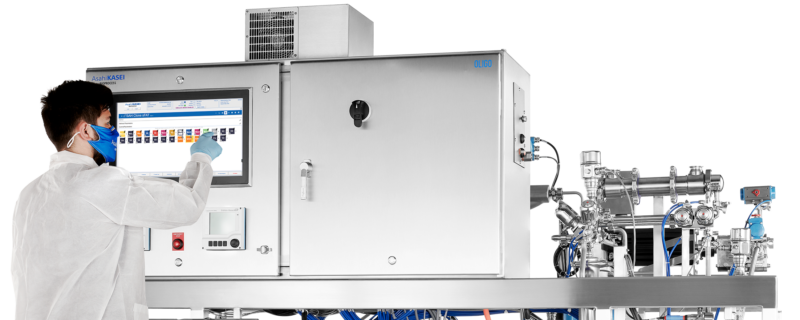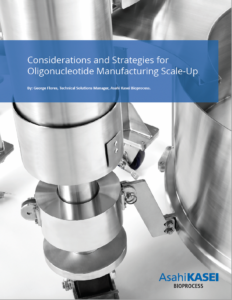
Key Considerations and Effective Strategies for Oligonucleotide Manufacturing Scale-Up
Oligonucleotide therapeutics have emerged as a powerful tool for targeting molecules that are beyond the reach of conventional drugs. With notable progress in nuclei acid chemistry and delivery mechanisms, these therapeutics are revolutionizing the treatment of cancers, genetic disorders and beyond. With a growing number of approved oligonucleotide therapeutics in the US, and many promising candidates in pipeline, oligonucleotides manufacturing will need to shift towards larger-scale processes to keep pace with demand. However, upscaling from benchtop processes presents significant challenges that must be addressed to ensure success.
Recognizing this need and understanding these challenges, Asahi Kasei Bioprocess (AKBA) has published a comprehensive white paper titled “Considerations and Strategies for Oligonucleotide Manufacturing Scale-Up“. This publication provides insights from bioprocessing experts who explore key challenges and outline potential solutions for pivotal steps in the oligonucleotide manufacturing process.
The white paper begins by describing the main steps in both upstream and downstream oligonucleotide manufacturing. The complexity, time requirements, and resource demands of oligonucleotide synthesis pose unique challenges for scale up. The authors emphasize that the goal during scale-up is to maintain the target product quality attributes and yield.
Upstream Manufacturing
The white paper delves into specific aspects of upstream manufacturing, including synthesis, cleavage, and deprotection. Optimizing column parameters, reagent selection, and reaction conditions for solid phase flow-through synthesis can improve synthesis efficiency and minimize the formation of unwanted impurities. The authors provide recommendations on reagents, vessel geometries and point out the importance of right-sizing the synthesis columns relative to the batch volume.
After synthesis, additional chemical processes involve cleaving the oligonucleotide from the solid support and deprotection through removal of the nucleobase protecting groups prior to downstream purification. While this step is straightforward, the authors suggest the adoption of automated cleavage and deprotection systems, which can streamline and standardize a crucial but often overlooked unit operation.
Downstream Manufacturing
In downstream manufacturing, purification technologies such as reversed-phase high performance liquid chromatography (RP-HPLC), ion exchange chromatography (IEX), and hydrophobic interaction chromatography (HIC) are examined. The authors highlight the challenges associated with column choice and recommend the use of Dynamic Axial Compression (DAC) column packing to achieve efficient impurity removal and high oligonucleotide recovery. Maintaining the ratio of the injection loop volume to the column volume throughout scale-up is also discussed as a key driver of successful chromatographic separation. By addressing these purification considerations, manufacturers can optimize the purification process for large-scale oligonucleotide production, ensuring high-quality products and efficient production workflows. Considerations during desalting and concentration and final lyophilization steps are also explored.
Facilities and Equipment Considerations
The unique requirements of upstream and downstream processes in large-scale oligonucleotide manufacturing necessitates a holistic approach to facility design that encompasses chemical handling, cold storage, clean rooms, and building utility systems to maintain a safe and controlled manufacturing environment. Sustainable chemistry practices and the selection of appropriate equipment, including automated software-controlled manufacturing platforms, are discussed as ways to increase efficiency, reproducibility, and cost-effectiveness.
Workforce
The rapid growth in the oligonucleotide field has created a skills gap in the labor market that will take time to resolve. The authors refer to automated technologies, such as automated cleavage and deprotection systems to simplify operations and reduce burden on highly trained personnel, which can help address the shortfall while the industry invests in training programs and initiatives to bolster resources and bridge the skills gap.
The white paper offers comprehensive insights and practical guidance for successfully scaling up oligonucleotide manufacturing. Leveraging the expertise of solutions providers like AKBA can help manufacturers navigate the complexities of scale-up in a rapidly growing and evolving therapeutic space.
We encourage you to download the white paper to dive deeper into the insights and get more detailed information on the concepts summarized – Considerations and Strategies for Oligonucleotide Manufacturing Scale-Up
